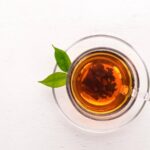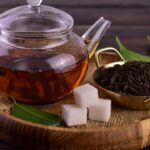If you’ve ever wondered what the most popular types of black tea are, we’ve got the answer.
This article will introduce you to the many varieties of black tea, the most common black tea blends, and how to choose the finest black tea for your specific needs.
Types of Black Tea
India, Sri Lanka, and China produce the most popular and well-known black teas. Every one of these countries grows its own black tea varieties, each with its own unique qualities.
Despite the fact that there are many types of black tea, we will focus on the most popular.
| Country | Popular Black Tea Types |
|---|---|
| China | Lapsang Souchong Keemun tea Yunnan tea |
| India | Assam tea Darjeeling Nilgiri tea |
| Sri Lanka | Ceylon tea |
Types of Chinese black tea
China produces some of the world’s greatest black teas. The following are three Chinese black tea varieties that are especially well-known around the world.
Lapsang Souchong

This is a smoked black tea from the Fujian Province of China’s Wuyi Mountains. The name is a combination of Lapsang, which means “smoky variety” and Souchong, which refers to the fourth and fifth tea leaves used to make Lapsang Souchong.
Tea experts consider Lapsang Souchong to be the world’s first true black tea. It has a distinct smoky pine flavor reminiscent of fine cigars and single-malt whiskey, making it distinct from other types of tea.
What is the taste of Lapsang Souchong?
It has a smokey flavor as a result of the leaves being finished over a local pine fire.
The smell is frequently more potent than the taste. When brewed, it should smell like a bonfire and have a pronounced pine aroma. It imparts a strong, warming flavor.
Keemun tea
This is a Chinese black tea that is grown solely in Qimen County in Anhui Province.
What is the flavor of Keemun?
Keemun tea may have a variety of taste profiles depending on the variety, quality, and method of brewing. It features a robust woody flavor character. Also, it’s slightly sweet but without the fruitiness, with a hint of nuttiness but without the earthiness or astringency.
The color of the tea beverage is coppery and reddish-brown. It is best when consumed on its own, without the addition of milk or creamer.
Yunnan tea
They are teas from Yunnan province, China. Dianhong is the local name for Yunnanese tea.
“Dian hong” translates into “Yunnan red tea” and today describes the vast majority of Yunnan black tea. The Chinese name “dian” refers to the Yunnan region, whereas “hongcha” means red tea, or what we call black tea in the West.
What does Yunnan tea taste like?
It has excellent malty aromas, along with a somewhat sweeter edge. Occasionally, flavors such as toffee, caramel, raisins, and dates appear. Due to the malty notes, Yunnan tea complements milk excellently.
Types of Indian black tea
India produces some of the world’s most well-known black tea varieties. Although tea manufacturing is not as ancient as it is in China, it has earned a global reputation through the production of several teas.
Most black teas in India are made from Camellia sinensis var. assamica, an Indian tea plant variety. Indian black teas are often strong and full-bodied in flavor, with high caffeine content.
Here are three of India’s most well-known black tea types:
Assam tea

This black tea variety is prepared from the leaves of the Camellia sinensis var. assamica plant. It is traditionally cultivated in Assam, an Indian state bordering Bangladesh, Burma, Bhutan, and China.
This region provides almost 50% of India’s total tea production, making it the country’s largest tea provider and the world’s largest tea-growing region.
Assam black tea has the highest caffeine content of all black teas. However, not all Assam teas contain a high concentration of caffeine. Caffeine content varies according to plant type, leaf type, grade, harvesting time, and brewing method.
Caffeine-rich Assam tea is often promoted as a morning drink. Most Irish and English breakfast teas contain Assam or a blend containing Assam.
What does Assam tea taste like?
It has a rich red color, a little astringency (bitterness), and a full-bodied taste. It’s an excellent tea to have with milk.
Darjeeling
In West Bengal, the Darjeeling and Kalimpong districts grow all the Darjeeling tea. Only tea recognized by the Tea Board of India may be termed Darjeeling tea.
Unlike Assam, this tea is made from Camellia sinensis var. sinensis. Its excellent taste, scent, and quality have earned it the nickname “the champagne of teas.”
What does Darjeeling tea taste like?
It has a distinct muscatel flavor reminiscent of muscat wine, although it can also have subtle vegetal, mossy, fruity, and citrus notes. The tea is often golden yellow, amber, orange, or brown in color.
In general, the tea’s taste is noted as being less bitter than other teas.
Nilgiri tea
This tea, also known as Blue Mountain tea, is grown at an extreme altitude in Tamil Nadu’s Nilgiri Mountains (the Blue Mountains). The peaks are part of the Western Ghats in South India’s southern region.
In the 1850s, similar to Darjeeling, the Nilgiri hills were cultivated with tea. Nilgiri teas, on the other hand, are significantly less well-known abroad than Darjeeling teas.
Nilgiri tea has a somewhat fruity, minty flavor, which is likely due to the region’s abundance of blue gum and eucalyptus trees. Perhaps the spices cultivated nearby give the mild brew a briskness (astringency), the capacity of tea to make your tongue pucker. Nilgiri tea’s balanced taste and texture make it a ‘blender’s pleasure.
Sri Lankan black teas
Ceylon tea
This black tea type, known as Ceylon tea, is a term that refers to tea grown in Sri Lanka’s highlands, formerly known as Ceylon.
Ceylon tea gained enormous popularity in the United Kingdom after Thomas Lipton began selling it in his chain of grocery stores after his purchase of land in Sri Lanka.
Sri Lanka’s tremendous diversity of altitudes and terroirs results in a vast array of taste characteristics from their tea plantations.
High-grown tea has a honey-golden liquid that is light and considered to be one of the greatest-tasting teas in the world. Low-grown tea has a burgundy dark liquor and a robust taste. The flavor of mid-grown teas is robust, rich, and full-bodied.
Ceylon black tea is said to be fragrant, brisker, and even fresher than other popular black teas.
The Most Popular Black Tea Blends
Because they’re so popular, we felt the need to include a section on blends. Blends exist for a lot of reasons, but the fundamental one is consistency.
Because tea is a natural product, its flavor may vary based on seasonality, growing circumstances, and other factors. By blending several varieties of black tea together, manufacturers may get equal flavors for a consistent product.
Frequently consumed black tea blends are:
- English Breakfast Tea
- Earl Grey
- Masala Chai
English Breakfast Tea
English breakfast tea is typically a combination of two or three different black teas. It is usually made with a combination of Assam, Ceylon, Keemun, or Kenyan black teas, although the exact teas used might vary widely.
The precise quantities of each type vary according to the tea manufacturer and their unique mix. Breakfast teas are often strong enough to be blended with milk or cream.
While English breakfast is not the only type of breakfast tea, it is unquestionably the most popular. Irish breakfast tea contains a higher proportion of Assam, whereas Scottish breakfast tea is stronger than English breakfast.
This black tea blend is robust and full-bodied, with a subtle sweetness. It should be robust without being bitter and bold enough to preserve its taste after milk and sugar are added.
This black tea blend’s aroma evokes the scent of newly cut plants or vegetables, and the more fermented the leaves, the stronger the aroma.
Earl Grey
Talking about tea blends would be incomplete without discussing the world’s most famous flavored blend, Earl Grey. This is a traditional blend of one or more black teas ( Assam, Ceylon, or Darjeeling) scented with bergamot orange rinds.
The bergamot orange is a citrus fruit that looks and tastes like a cross between an orange and a lemon, with hints of grapefruit and lime.
Black tea is flavored with bergamot rinds, oil, or artificial bergamot flavoring. Avoid artificial flavorings and opt for blends produced with oil of bergamot and rinds of bergamot as the primary ingredients.
The bergamot flavor infuses black tea with a zesty note, giving this tea blend a bit more vibrancy than other breakfast teas.
The traditional Earl Grey tea has citrus and malty aromas. Some individuals love to add a dash of milk to their Earl Grey, while others prefer to add a slice of lemon.
Masala Chai
This is technically not a type of tea but a beverage produced by brewing black tea with spices, sugar, and milk. Masala Chai is a spiced milk tea.
Masala chai is primarily made up of a premium Assam black tea blend spiced with cinnamon, cloves, cardamom, ginger, and black pepper. Other spices, such as anise or nutmeg, are sometimes used.
The spices you use, the amount of water and milk you use, and the type of tea you use are all personal preferences, and they all contribute to the flavor, strength, and taste of your masala chai.
How to Select the Best Black Tea for Your Needs
Individual preferences and tastebuds will dictate which type of black tea is most suited for you. Organic black tea is the best way to enjoy a fine cup of tea. It’s not going to be the best black tea if you buy it in a teabag from the local store!
In addition to not letting the flavors fully develop while steeping, the little black tea bags that are used in this way are made of poorer black tea that has been machine-processed.
If you want to get the most out of your cup of black tea, you’ll want to go with loose-leaf premium organic teas. Also, it is good to know that there are some periods of the day when it is best to sip a cup of black tea. More on this in our detailed post on the best time to drink black tea.
If you’re looking for a strong, high-caffeine black tea, try Assam, Irish, or English Breakfast tea. Keemun and Yunnan black teas from China are wonderful options for mild, medium-caffeine black tea. Try Nilgiri black tea or Lapsang Souchong black tea if you wish to expand your tea experiences.
Last but not least, you should experiment with several types of black teas to discover which one suits your taste buds best.
Thanks for checking out our guide to the most popular types of black teas. For a great cup of black tea, the choice is entirely yours.



